The Birth of the Pentagon
On January 15, 1943, the Pentagon, an architectural and military marvel, officially opened its doors in Arlington, Virginia. Designed to serve as the headquarters of the United States Department of Defense, the Pentagon remains the world’s largest office building, both in floor space and historical significance.
Why the Pentagon Was Built
In the early 1940s, as the U.S. prepared for the challenges of World War II, there was an urgent need for a centralized facility to coordinate military operations. Before the Pentagon, the War Department was scattered across numerous buildings, leading to inefficiencies in communication and strategy.
President Franklin D. Roosevelt approved the project in 1941, and construction began on September 11, 1941, just months before the U.S. entered World War II.
Architectural Feat and Unique Design
The Pentagon’s distinctive five-sided design is a result of practicality and ingenuity. Originally planned for a different site with pentagonal boundaries, the design was retained even when the location shifted.
Key features of the Pentagon include:
- 17.5 miles of corridors connecting its five concentric rings.
- A central courtyard spanning five acres, providing an open space for relaxation.
- Its innovative layout ensures that no two points are more than seven minutes apart by walking.
At the time, the project was an engineering triumph, completed in just 16 months—a remarkable feat given its massive scale and wartime challenges.
Role in Military History
From its inception, the Pentagon has been the nerve center of U.S. military operations. During World War II, it played a crucial role in coordinating the efforts of the Army and Navy. Over the decades, it has witnessed pivotal moments in American history, from the Cold War to the Global War on Terrorism.
One of the Pentagon’s most somber days came on September 11, 2001, when it became a target of the terrorist attacks. The tragedy highlighted its enduring symbolism as the heart of U.S. defense and resilience.
Fun Facts About the Pentagon
- With 6.6 million square feet of space, the Pentagon could house three Empire State Buildings.
- The building cost $83 million to construct, equivalent to approximately $1.4 billion today.
- It’s a city unto itself, complete with food courts, shops, and post offices.
The Pentagon’s Legacy Today
Today, the Pentagon is not just a hub of military activity but also a symbol of American strength and unity. It stands as a testament to the nation’s ability to innovate and adapt during challenging times. Visitors from around the world come to tour the facility, learning about its history and ongoing contributions to global security.
| Fact | Details |
|---|---|
| Construction Start Date | September 11, 1941 |
| Completion Date | January 15, 1943 |
| Total Floor Area | 6.6 million square feet (3.7 million square feet used as office space) |
| Cost | $83 million (approximately $1.4 billion in today’s dollars) |
| Corridor Length | 17.5 miles |
| Maximum Walking Distance | No two points are more than seven minutes apart on foot |
| Shape | Five-sided (pentagon) |
| Significance | Largest office building in the world by floor area |
| Major Event | Targeted during September 11, 2001, terrorist attacks (western side struck by Flight 77) |
| Construction Timeframe | 16 months |
Conclusion – Pentagon Opens 1943
The opening of the Pentagon in 1943 marked a transformative moment in U.S. history. It streamlined military operations during a critical time and has since become an enduring icon of national defense.





Can you be more specific about the content of your article? After reading it, I still have some doubts. Hope you can help me.
Your article helped me a lot, is there any more related content? Thanks!